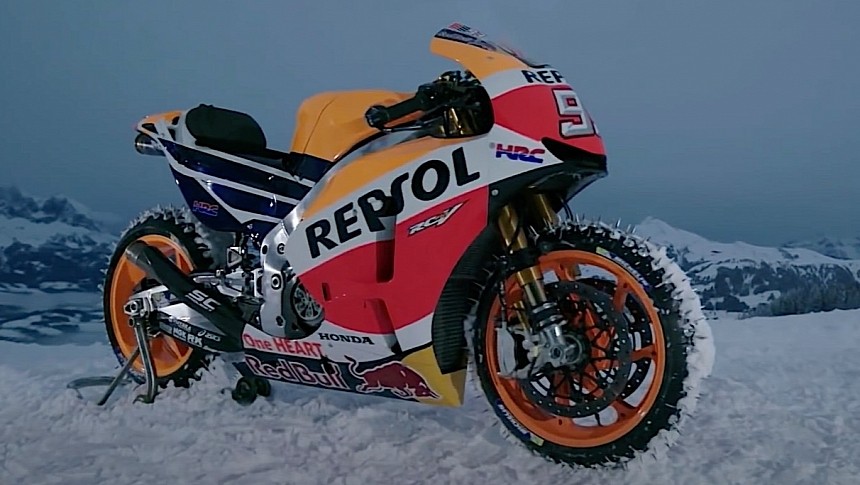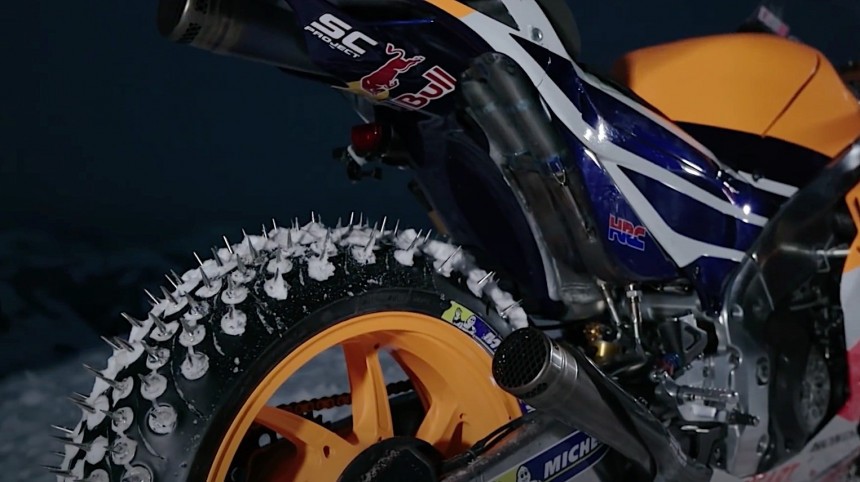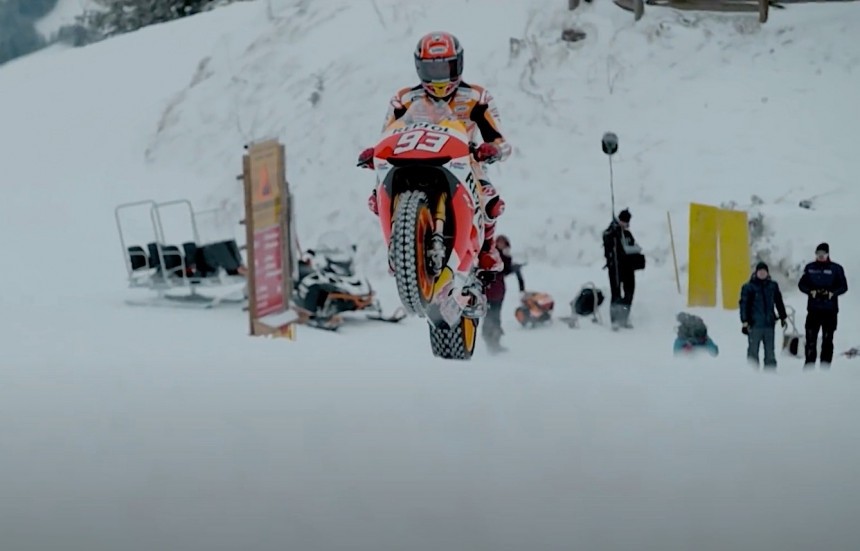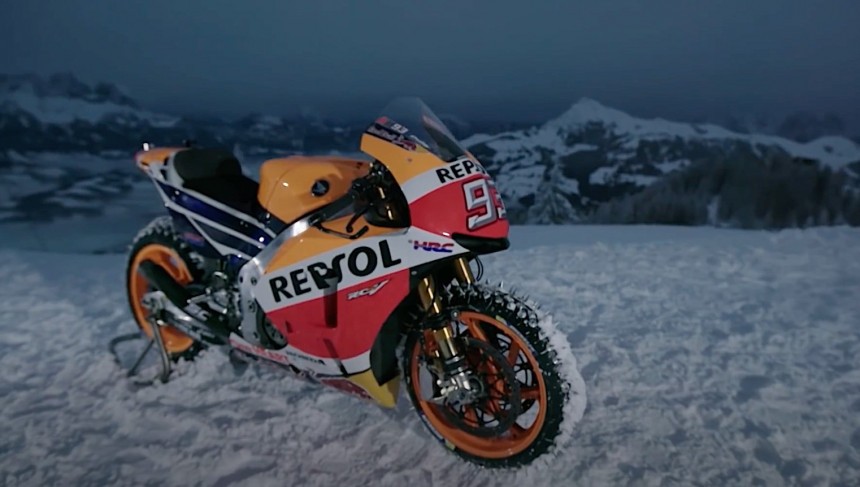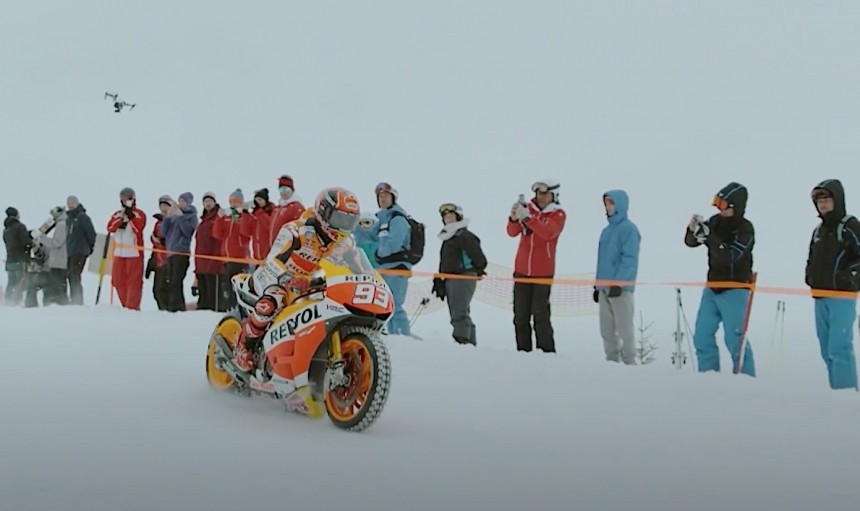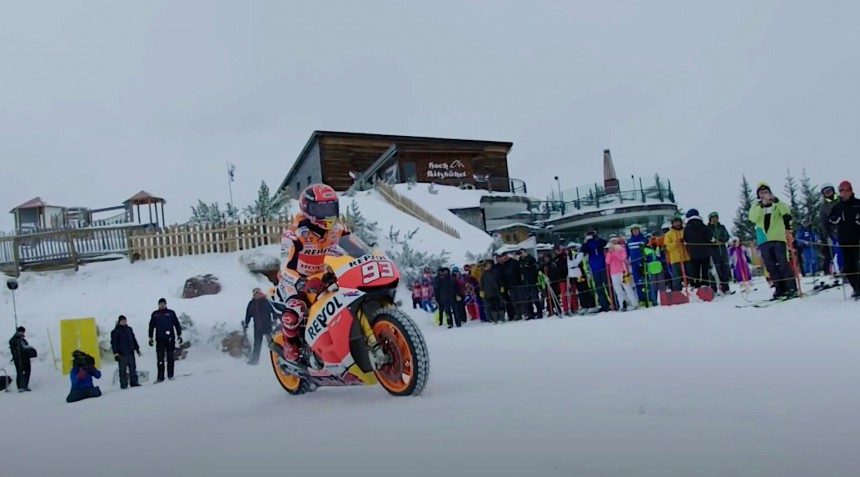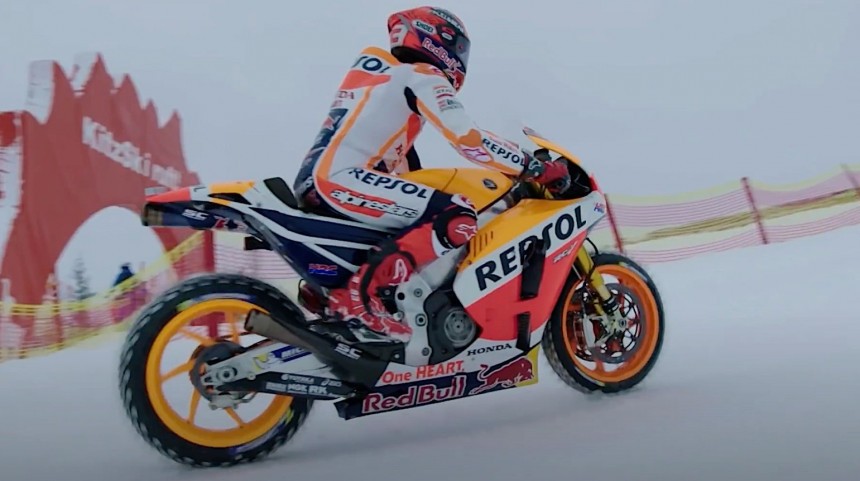Even if a quick foray out your front door will have you convinced it's spring (at least here where I live), winter is almost upon us. It may come a little later than usual, but it will come, and with it all the hardships we're used to.
Winter, or more specifically the cold temperatures and precipitation, be it as rain or snow, that come with it, affect everything around us, including the vehicles we use for our daily dealings. All of them, no matter the type, have to be properly prepped to handle the new conditions and still operate as advertised.
When it comes to cars, winter preparations include anything from getting some anti-freeze to fitting tires capable of better handling slippery conditions. Every single driver who lives in an area where winter manifests itself in the classic way does this each year, and for a simple reason: winter does not stop cars from moving, and people from using them.
Not the same can be said about motorcycles. Because of the way they are built, motorcycles are almost impossible to find on the snow-covered streets of the world. Sure, they do ride in the cold months, but mostly in areas where winter only means a slight drop in temperature from comfortable values.
Why is that so? Why are motorcycles so bad in winter? And if we can't use them, what can we do to keep the bikes safe and functional until better weather is upon us? These are some of the questions this piece plans to answer below.
You all know how a car looks. Four wheels to support a chassis, a body on top of that, and an engine, generally installed at the front. But there's one thing that makes cars special, in the way they can operate no matter the outside weather: a habitat.
That interior space, no matter how small or large, can be heated and cooled at will. This means it can rain, snow, or be scorching hot, the people inside feel none of that.
Motorcycles do not have habitats, and this is the first reason why motorcycles are so bad to use in winter. The rider operating them is always exposed to the elements, and he can only rely on suits and other gear for some degree of protection. No matter the gear used, though, rain, snow, and freezing temperatures become at some point impossible to ignore and handle.
A lot of you are probably wondering when it becomes too cold to ride a motorcycle? The answer to that depends on a lot of factors, ranging from how a person is built to the presence of wind (or the speed of the bike) to amplify the effects of the cold.
Technically speaking, if a person has enough natural resistance to cold, and the proper protective gear, you could ride a bike no matter what the outside temperature gauge reads. It is, however, recommended not to do that when the needle drops to 32 degrees Fahrenheit (0 degrees Celsius).
Such cold in some cases could make the temperature of the human body drop dangerously close to hypothermia. Especially given how studies have shown that doing just 20 mph (32 kph) in 32 degrees will make you feel like it's 21 degrees Fahrenheit (minus six degrees Celsius). And the faster you go, the colder it gets - you can check the Wind Chill Chart from the National Weather Service available in the attached gallery.
But it's also the temperature where freezing occurs, and we all know motorcycles really suck at handling themselves on ice and snow. And this is the second reason why motorcycles are bad to use in the winter.
Remember the four wheels of the car I mentioned earlier? Well, the fact that they are placed far apart at the corners of a sort of rectangle, combined with their ability to be shod in winter tires, makes car wheels quite proficient at handling, up to a point, snow and ice.
Motorcycles have just two wheels, positioned in a line. It's what makes them so difficult to handle by some people regardless of weather conditions, but also what prevents even the most experienced riders from attempting snow travels: motorcycles slip more easily, and because of the lack of that habitat we spoke about before, with much more serious consequences.
So, bikes suck in winter, but that doesn't mean we should discard them as soon as bad weather gets here. The only solution in hand for motorcycle owners is to store the machines the best way they can, so that a few months later they could be used as if nothing happened.
For some of us, storing a motorcycle for winter comes down to just shutting down the engine at some point and forgetting all about the bike for several months. It's sad, but it does happen.
That, of course, is not the way to go about this. Although getting a bike ready for hibernation is not a very complicated task, it does require a few steps that will make it readier for future travels than just parking it and throwing the key away.
Those steps are heavily influenced by where the bike will be stored, outside or inside. There are however commonalities, so I'll start with those, in the order they should be performed.
The main thing you should do when putting the two-wheeler away is think you're about to begin a new, long trip. That's right, the exact opposite of what you're doing, and it should become clear why in a minute or two.
Make sure to thoroughly wipe off all the water after you're done, as leaving it there might open the door for rust and corrosion to come in. Using wax and other protective solutions is not mandatory, but if you plan to give your ride an extra layer of protection, go for it.
You should do this because the presence of fluid where it's needed will help better protect the motorcycle's parts during the months of inactivity. That means corrosion will not find a way in, and you'll be able to hop on and ride away as soon as the weather permits.
You should be careful though not to just simply fill up all the tanks and leave. Since you're changing the oil, do the same with the oil and air filters as well.
On top of that, batteries also have a tendency to discharge on their own over time, so having a charger ready when it's time to hop back on is advised.
To make sure you won't find unwanted guests in the exhaust, and to ensure it doesn't get clogged with some sort of debris, use plugs. You should do the same for any other opening your bike might have, like say the air intakes. Do remember to take the plugs off when it's time to ride, otherwise you could be in for some nasty surprises.
There's technically no place the air in your tires can go to, if they are in good shape, but it's always a good idea to inflate them to the suitable specifications.
Leaving a tire in the same position for long periods of time could cause them to flatten where it makes contact with the ground, so it's a good idea to spin them every now and then. Given how you've already disconnected the battery, you'll probably have to do that the good old-fashioned way, by simply pushing the bike around.
That's a dumb question, I know, as it's not as much a choice as it's making do with what you have available. But there are particularities for each storage medium, and that's what we'll talk about here.
Technically speaking, you could store a motorcycle pretty much anywhere. Yet most of us have only one choice when it comes to storing a motorcycle for winter: outside. And it means that, aside from everything that's mentioned above, a few more things need to be done.
The first thing is to fill the bike with some anti-freeze to keep it, you know, from freezing. The stuff is an additive that lowers the freezing point of water-based liquids. If one of them does freeze, it automatically expands, and that could damage the bike's parts.
Second on the list should be a cover to protect the motorcycle from the elements and whatever nature plans to throw at it in time.
It's also a good idea to have some sort of anti-theft device in mind to make sure you still have something to ride once winter is over.
Make sure the spot you choose to park your bike doesn't put it at risk of being towed, or yourself in danger of getting a ticket.
Inside storage for a motorcycle is always recommended. Some people even consider taking the bike inside their homes – and even if technically there's no reason why you shouldn't be able to do that, that's to be avoided. If you don't have a space of your own, maybe you should consider renting a storage unit for the motorcycle for the duration of the cold months.
Inside storage can come in two forms, either with or without climate control. In the case of indoor storage without climate control, you should consider the bike as being outside, and still fill it with anti-freeze. You could, however, give up on the cover (although, to be fair, it's a good idea to keep one on) and anti-theft system (if the structure has some way of securing entry).
When going for a controlled-climate room, you could relax even further and give up on anti-freeze as well. That's because if you don't need an extra boost not to freeze, the motorcycle surely won't.
If you really want to keep riding your motorcycle during the winter months, you should probably consider moving to a place that's less harsh, climate-wise. Yet there is no law that I know of to stop you from riding a motorcycle during the winter no matter where you are, so here's what you need to know if you really, really can't stop yourself.
The first and most important thing you should know is you should never ever ride a bike on snow and ice. It can be done, of course, but that mostly happens on closed circuits and with experienced riders in control (just have a look at the video below and you'll know what I mean). Doing it on public roads is extremely dangerous, because slippery conditions give the two-wheeler a mind of its own.
You should always check the weather conditions on the route you plan to take and make the necessary adjustments to avoid problem areas.
Make sure that your motorcycle and all of its systems are in working order – lights, controls, fluids, and engine. Equipping the bike with winter tires is highly recommended – there aren't all that many of them to go around (at least not compared to regular ones), but all the major producers offer such solutions: Avon, Bridgestone, Continental, Dunlop, Michelin, Pirelli, and even Metzeler.
Gear up. You always do that when getting in the saddle, but for winter riding you'll need special jackets, gloves, boots, and to some extent even a special kind of helmet.
The bottom line, you can ride a motorcycle during cold winter months, but it won't be the most pleasant of experiences. So, really now, go and put your bike away for a few months.
When it comes to cars, winter preparations include anything from getting some anti-freeze to fitting tires capable of better handling slippery conditions. Every single driver who lives in an area where winter manifests itself in the classic way does this each year, and for a simple reason: winter does not stop cars from moving, and people from using them.
Not the same can be said about motorcycles. Because of the way they are built, motorcycles are almost impossible to find on the snow-covered streets of the world. Sure, they do ride in the cold months, but mostly in areas where winter only means a slight drop in temperature from comfortable values.
Why is that so? Why are motorcycles so bad in winter? And if we can't use them, what can we do to keep the bikes safe and functional until better weather is upon us? These are some of the questions this piece plans to answer below.
Why are motorcycles so bad to use in winter?
That interior space, no matter how small or large, can be heated and cooled at will. This means it can rain, snow, or be scorching hot, the people inside feel none of that.
Motorcycles do not have habitats, and this is the first reason why motorcycles are so bad to use in winter. The rider operating them is always exposed to the elements, and he can only rely on suits and other gear for some degree of protection. No matter the gear used, though, rain, snow, and freezing temperatures become at some point impossible to ignore and handle.
A lot of you are probably wondering when it becomes too cold to ride a motorcycle? The answer to that depends on a lot of factors, ranging from how a person is built to the presence of wind (or the speed of the bike) to amplify the effects of the cold.
Technically speaking, if a person has enough natural resistance to cold, and the proper protective gear, you could ride a bike no matter what the outside temperature gauge reads. It is, however, recommended not to do that when the needle drops to 32 degrees Fahrenheit (0 degrees Celsius).
But it's also the temperature where freezing occurs, and we all know motorcycles really suck at handling themselves on ice and snow. And this is the second reason why motorcycles are bad to use in the winter.
Remember the four wheels of the car I mentioned earlier? Well, the fact that they are placed far apart at the corners of a sort of rectangle, combined with their ability to be shod in winter tires, makes car wheels quite proficient at handling, up to a point, snow and ice.
Motorcycles have just two wheels, positioned in a line. It's what makes them so difficult to handle by some people regardless of weather conditions, but also what prevents even the most experienced riders from attempting snow travels: motorcycles slip more easily, and because of the lack of that habitat we spoke about before, with much more serious consequences.
So, bikes suck in winter, but that doesn't mean we should discard them as soon as bad weather gets here. The only solution in hand for motorcycle owners is to store the machines the best way they can, so that a few months later they could be used as if nothing happened.
Getting a motorcycle ready for winter storage
That, of course, is not the way to go about this. Although getting a bike ready for hibernation is not a very complicated task, it does require a few steps that will make it readier for future travels than just parking it and throwing the key away.
Those steps are heavily influenced by where the bike will be stored, outside or inside. There are however commonalities, so I'll start with those, in the order they should be performed.
The main thing you should do when putting the two-wheeler away is think you're about to begin a new, long trip. That's right, the exact opposite of what you're doing, and it should become clear why in a minute or two.
1. Wash the bike
It may sound a bit futile to wash the motorcycle given the upcoming months of inactivity, but doing that might prevent some unwanted problems later, aside from leaving it shiny and clean. For instance, a large amount of dirt may prove harder to remove after it's been sitting there for months, hardening.Make sure to thoroughly wipe off all the water after you're done, as leaving it there might open the door for rust and corrosion to come in. Using wax and other protective solutions is not mandatory, but if you plan to give your ride an extra layer of protection, go for it.
2. Fill the motorcycle with all the fluids it needs
Just like everything else in this world, if it's meant to be filled with fluids, then by all means, fill it. That includes everything and anything from engine oil and brake fluid to fuel and coolant.You should do this because the presence of fluid where it's needed will help better protect the motorcycle's parts during the months of inactivity. That means corrosion will not find a way in, and you'll be able to hop on and ride away as soon as the weather permits.
3. Add some fuel stabilizer
This will prevent the liquid from losing its properties over time.4. Disconnect the battery
Just like with cars, leaving a motorcycle sitting around for months could have devastating effects on the battery. That's because even if you haven't forgotten the lights on, for instance, some of the motorcycle's system will still drain it.On top of that, batteries also have a tendency to discharge on their own over time, so having a charger ready when it's time to hop back on is advised.
5. Cover those exhaust pipes
To insects and other "wildlife", as well as for dust and other debris, any hole looks like a potential home. And your bike's exhaust has at least one such large home available.To make sure you won't find unwanted guests in the exhaust, and to ensure it doesn't get clogged with some sort of debris, use plugs. You should do the same for any other opening your bike might have, like say the air intakes. Do remember to take the plugs off when it's time to ride, otherwise you could be in for some nasty surprises.
6. Inflate the tires and spin them once in a while
Ideally, a motorcycle should be stored in an elevated position, with the wheels off the ground, but most of the time that's not possible.There's technically no place the air in your tires can go to, if they are in good shape, but it's always a good idea to inflate them to the suitable specifications.
Leaving a tire in the same position for long periods of time could cause them to flatten where it makes contact with the ground, so it's a good idea to spin them every now and then. Given how you've already disconnected the battery, you'll probably have to do that the good old-fashioned way, by simply pushing the bike around.
7. Start it up on a regular basis
There is no definite as to how often you should do this, but if you punch some life into that engine every few weeks or so for a few minutes, things will be a lot easier when winter ends.Where to store a motorcycle?
Technically speaking, you could store a motorcycle pretty much anywhere. Yet most of us have only one choice when it comes to storing a motorcycle for winter: outside. And it means that, aside from everything that's mentioned above, a few more things need to be done.
The first thing is to fill the bike with some anti-freeze to keep it, you know, from freezing. The stuff is an additive that lowers the freezing point of water-based liquids. If one of them does freeze, it automatically expands, and that could damage the bike's parts.
Second on the list should be a cover to protect the motorcycle from the elements and whatever nature plans to throw at it in time.
It's also a good idea to have some sort of anti-theft device in mind to make sure you still have something to ride once winter is over.
Make sure the spot you choose to park your bike doesn't put it at risk of being towed, or yourself in danger of getting a ticket.
Inside storage for a motorcycle is always recommended. Some people even consider taking the bike inside their homes – and even if technically there's no reason why you shouldn't be able to do that, that's to be avoided. If you don't have a space of your own, maybe you should consider renting a storage unit for the motorcycle for the duration of the cold months.
Inside storage can come in two forms, either with or without climate control. In the case of indoor storage without climate control, you should consider the bike as being outside, and still fill it with anti-freeze. You could, however, give up on the cover (although, to be fair, it's a good idea to keep one on) and anti-theft system (if the structure has some way of securing entry).
When going for a controlled-climate room, you could relax even further and give up on anti-freeze as well. That's because if you don't need an extra boost not to freeze, the motorcycle surely won't.
But what if I really want to ride in winter?
The first and most important thing you should know is you should never ever ride a bike on snow and ice. It can be done, of course, but that mostly happens on closed circuits and with experienced riders in control (just have a look at the video below and you'll know what I mean). Doing it on public roads is extremely dangerous, because slippery conditions give the two-wheeler a mind of its own.
You should always check the weather conditions on the route you plan to take and make the necessary adjustments to avoid problem areas.
Make sure that your motorcycle and all of its systems are in working order – lights, controls, fluids, and engine. Equipping the bike with winter tires is highly recommended – there aren't all that many of them to go around (at least not compared to regular ones), but all the major producers offer such solutions: Avon, Bridgestone, Continental, Dunlop, Michelin, Pirelli, and even Metzeler.
Gear up. You always do that when getting in the saddle, but for winter riding you'll need special jackets, gloves, boots, and to some extent even a special kind of helmet.
The bottom line, you can ride a motorcycle during cold winter months, but it won't be the most pleasant of experiences. So, really now, go and put your bike away for a few months.
